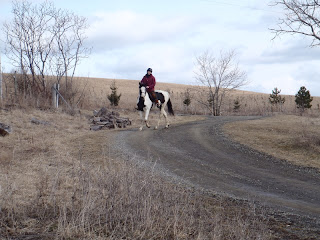I decided to take my own advice yesterday, and made a trip to the Critical Topics in the Equine Industry program, sponsored by the NYS Farm Bureau and held at the Cortland Grange. My husband and I made a day of it, stopping at a Mihandra tractor dealer open house in Binghamton to look at the big machines, then headed to Cortland.
 |
| Susan presents at the NYS Farm Bureau program in Cortland. |
Even though I had entered the information about this program in the BIG Calendar, had shown it to my husband AND recommended it to readers, I still did not realize who I was about to see present. Among the line up of presenters was Susan Harris.
Some of you are saying, "OK, nice. So?" While others of you immediately realized that Susan Harris is an internationally known instructor, clinician, illustrator and author of many well known books, including -- be still my heart -- the BIBLES of horsemanship: The United States Pony Club Manuals.
Holy Toledo! I was among greatness and didn't even realize it. Who knew the author of these fantastic books lives in Cortland, NY?
In addition to the most recent editions of the Pony Club Manuals, Susan has written another book on my shelf: Horse Gaits, Balance and Movement.
I bet you egghead types out there might even have a book of hers on YOUR shelf. Here's the list: Horsemanship in Pictures, Horse Gaits, Balance, and Movement, Grooming to Win, the three U.S. Pony Club Manuals of Horsemanship, and the USPC Guides to Longeing, Bandaging, and Conformation.
She also writes a regular column in EQUUS Magazine, Commonsense Horsemanship with Susan Harris. Also, with Peggy Brown, she produced two DVDs: Anatomy in Motion™ I: The Visible Horse, and Anatomy in Motion II: The Visible Rider™.
She is immediately recognizable as a clinician when she presents with "the visible horse," a real horse painted to show muscles, bones and tendons in great detail, thus:
Susan's presentation yesterday focused on horse movement and how important it is for a rider to help a horse use its muscles correctly to be able to carry a rider. She said something that helped me remember why it is important to find engagement and collection:
"It's really important for a horse, when it carries a rider, to learn how to use his body well, and no horse will move with a rider the same way he does when he runs free," she said. "Engagement of the hind quarters switches a horse from pulling power to carrying power."
She talked about the many ways we see horses forced into the appearance of collection/engagement, including a "frame" and rollkur, and stressed that they are harmful to the horse's body and ability to move correctly.
The program was well attended, with more than 60 people in the audience, and other presenters also offered good information, which I'll touch on in another post. For me, Susan definitely made the trip very worthwhile!
















